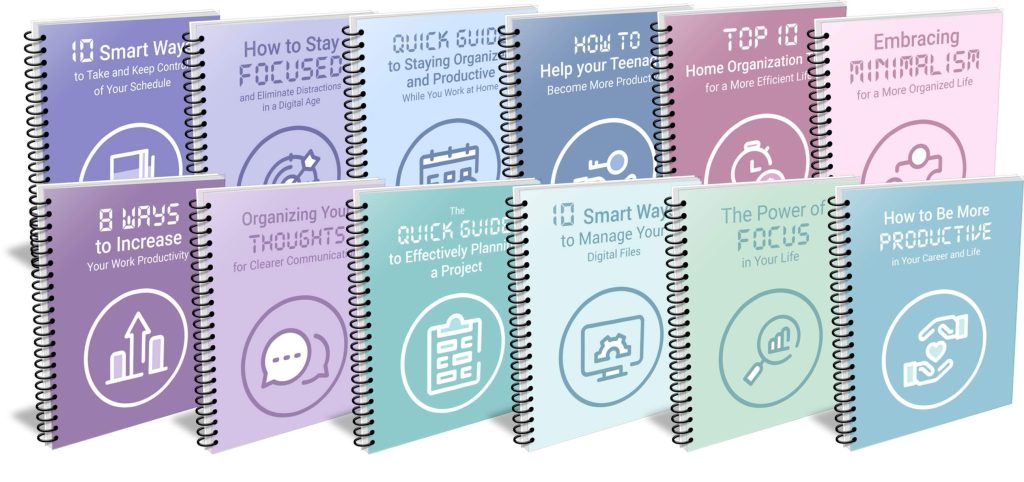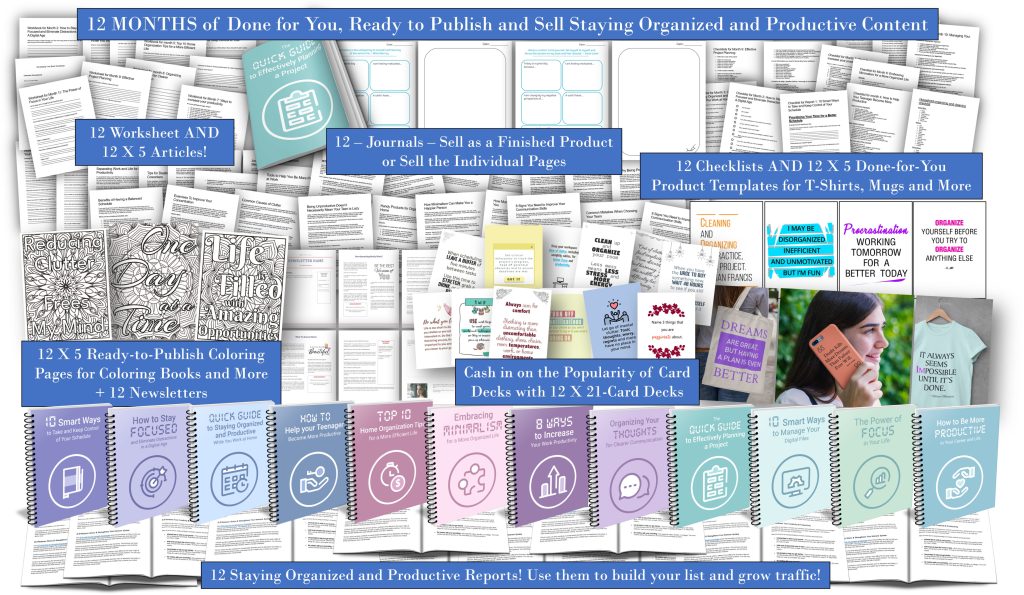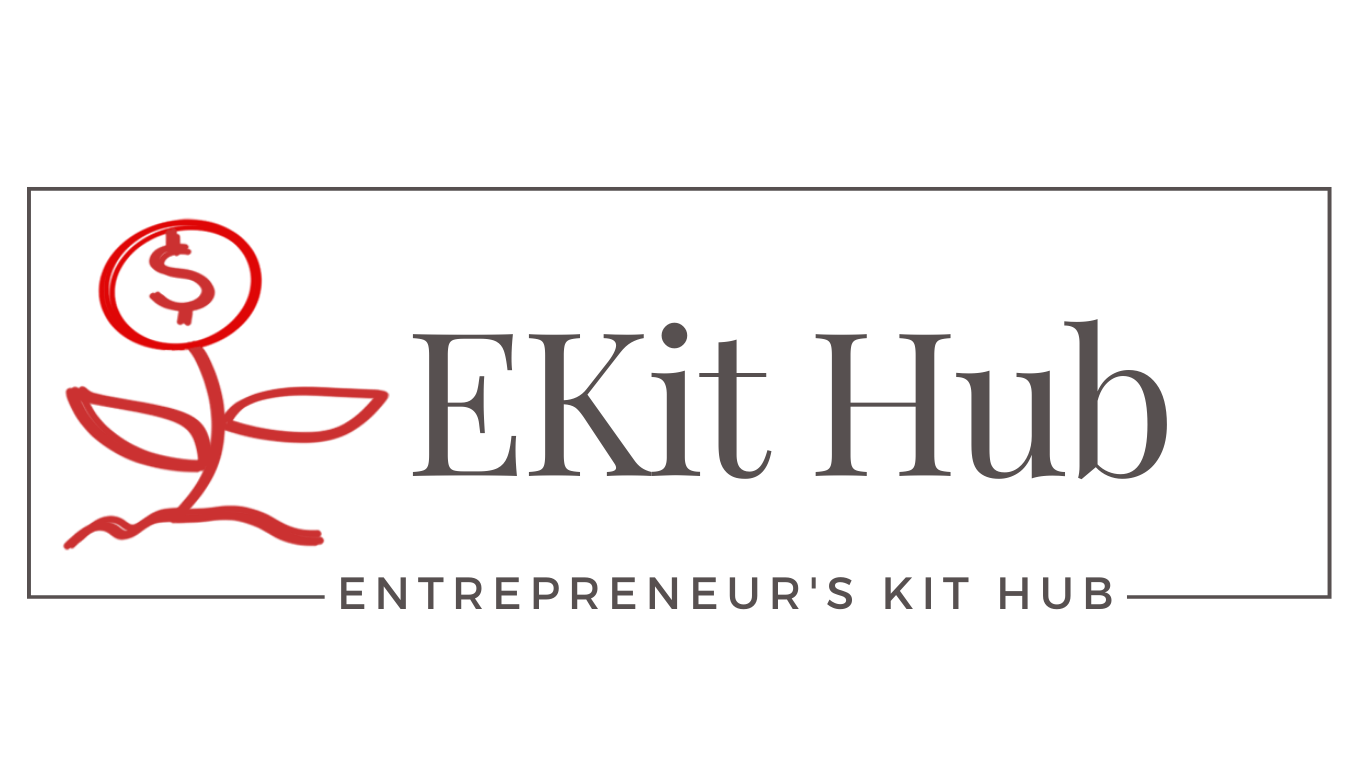If you're like many of our customers who sell printables, coaching programs and info products…a very popular topic is the organization and productivity niche. If this is one of your passions, this tutorial will be very useful in helping you come up with a game plan with starting your own organization or productivity business.
And the great news is, organization and productivity niches are BOOMING markets (with many multiples of billions of dollars in sales each year), so you've chosen well. And now that due to the Covid pandemic, most people are staying at home and working at home…and more importantly, trying to create a work-life balance, these markets will continue to grow.
Here's what you can expect in this tutorial:
1. Market statistics in the organization and productivity niche.
2. What are some popular topics in this market?
3. Types of products you can sell and promote.
4. How to build your audience in this market.
5. How to get a year's worth of done-for-you content for an easy start in this niche.
#1: Market Statistics in the Organization and Productivity Niche
As mentioned the organization and productivity niche offers huge potential in the form of tens of billions in sales each year. The Covid pandemic has contributed to great growth and increased potential as people are spending more time at home, working and home, and are trying to achieve that elusive work/life balance.
According to Freedonia, in the U.S. alone, home organization products are projected to be a $13.5 billion industry by 2025. And when it comes to productivity, just productivity software alone was $41.96 billion dollar market in 2020 and is projected to grow 14.49% by 2026, according to Verified Market Research. The University of Chicago did a research study that found the average worker spent 14 hours and $600 to support their new work at home lifestyle.
From a collection of statistics collected by House Grail, overall productivity is up 47%. Clearly, it's important to people to manage their time and work wisely.
The growth of the “home office” is an interesting one and spending on it grew 12.4% between 2015-2021, according to Future Market Insights. BUT, the home office is where people are doing work, conducting research for personal purposes, studying and more. It's a versatile place in the home.
And of course, organization and productivity in the corporate world are still important and remain huge industries as well.
#2: Popular Topics in the Organization and Productivity Niche
Obviously, there are so many directions you can go in with this market…and even within those directions, you can always go deeper. It's important to do your research and experimentation to see what will work well for you as a business.

Here is a starter list of 12 ideas that also happen to be the main topics in our Year's Worth of Done-for-You Staying Organized and Product Content EKit.
If you like any of these, be sure to grab the year's worth package and then you can use the content that applies. And if you're not sure where you'd like to put your focus, this cost-effective content package makes it easy for you to experiment.
- Scheduling and Planning
- Living in the Digital Age of Distractions
- Work at Home
- Help Your Teenager Be More Productive
- Home Organization & Decluttering
- Minimalism
- Work and Career Productivity
- Organization of the Mind
- Project Planning
- Digital Organization
- Staying Focused
- A Productive Life
#3: Some Types of Products You Can Sell and Promote
The great thing about starting an online business is that it means you can promote different types of products, but you don't necessarily need to create them or put them in your inventory. And for the products you do create, you can keep your work strictly digital…so there are no expensive start up costs or need for extra storage in your own.
A Few Ways to Sell Products:
- Create and sell them yourself. You can create products like courses, coaching programs, printables or even sell your services. Anything that helps them get more organized and productive.
- Use print-on-demand companies that you allow you to upload your designs, but they create the product and ship to your customer. There are companies like Gooten, Gelato, Lulu and others that can help you create and ship out physical products, without you having to do handle any of the physical aspect. You just design or write the product…they take care of the rest.
- Promote other people's products via an “affiliate program”, which means you get a special tracking link to share another company's products and when anyone buys through your link, YOU get credit for the sale. You could sell organizational systems, other people's productivity course, printables and tons more.
Most successful online businesses do a combination of the above. Having your own product line helps you build an even more fiercely audience that spreads the word about you…but where there are gaps in your product offerings and what you want to teach, you can promote other people's products.
A few ideas to get you going…
Scheduling and Planning Products
There are so many amazing things you can create and sell to help people schedule and plan better. They could be printable or physical products you (or a 3rd party) ships to them. Things like planners, guided journals, checklists, to do lists, courses, coaching and more.
Office Organization Products (Home or Traditional):
The office always needs organization, but be sure to be clear on the audience you want to build. If you focus just on home office, for example, you are much better able to target your content and advertising to that audience's particular unique needs.
You can create printable products like calendars, planners, to do lists, checklists and other organizational tools. You can sell physical items that help organize office space and the various tools and supplies you'd find in an office. They also need digital organization and communication tools and software, which is a huge growing opportunity.
Work, Career and Life Productivity Products
There's a lot of potential here. You can focus on an audience with a particular career or specifically entrepreneurs, etc…but being able to balance that with their life is often important too. But as an entrepreneur yourself, you get to decide what focus you want to take to best help people.
You can sell products that will help them get more done in a day (productivity apps, programs, spreadsheets, planners, etc.) or ones that help them prioritize their life, so they stay focused on the most important things in their lives.
Home Organization Products
The home has countless things to organize, so there is never a shortage of products to sell here.
For example, you can create menu plans and shopping lists for different purposes. You could focus on families with young picky eaters. Busy people or families who barely have time to cook. People who have certain dietary requirements, want to lose weight or just want to be more healthy.
Of course, there are lots of opportunities in different areas of the house. For example, help them organize their kitchens with organizational products, teach them how to keep inventories and more. And people need help with the garage, kids rooms, dens and tons more.
There are also opportunities in helping people manage the maintenance of their home (schedules, checklists, how tos). They also need help decluttering, which is an endless process in a material society like ours. You can teach decluttering courses, give them mindset tools to prevent the creation of clutter, etc.
#4: How to Build Your Audience in this Market
As you can tell by now, marketing is all about the audience, but audiences are not all created equal. It's important to understand who your target CUSTOMER is, so you can build an audience people who want to buy what you have to offer. That means, you want to create and share content that the ideal buyer would want to consume.
We talk a lot about this in our FREE EKitHub University course here, but for now…let's give you a good starter plan here.
There are 3 important components to building your audience if you want a long-term sustainable business that sells products.
A: Build Traffic
B: Grow Your Mailing List
C: Nurture Your List
Let's look into each of these…
A: Build Traffic
Gaining traction to a new business through traffic isn't always easy, but consistent effort pays off over time. Always keep in mind, that a little work each day over a year pays off much more than being frustrated with no progress and being inconsistent as a result. So work on it a little each and every day.
Ultimately, you want most of your traffic to end up on your own website and have those visitors funnelled into signing up for your list (discussed in the next section). So whether you use social media, YouTube or another site to build your initial following, have a plan to leverage your own virtual real estate to (i.e. your website). Avoid building your business solely on other people's platforms.
Looking at the content in our Year's Worth of Staying Organized and Productive Content EKit, let's use what we have there as examples of how to grow your traffic.
- Publish articles. Post articles to your blog. You can also publish snippets or full pieces on social media. The year's worth package includes 60 done-for-you articles that you can publish.
- Use the poster graphics with inspirational sayings to create commentary on your niche topic. We’ve included 60 thought-provoking inspirational graphics that you can post to social media, your blog, etc…and they are great to use as writing prompts as well. Talk about why you are sharing the saying shown on the graphic to show yourself as an expert and to connect with your audience.
- Repurpose reports and articles into videos. Use them as a script and add your own thoughts.
- Give away coloring pages. Coloring pages can be a huge traffic generator as people (adults and children alike) are often looking for free pages to download and print. The year's worth package includes 60 coloring pages you can put to work for you.
- Give away checklists and worksheets. These handy printables for doing and managing various tasks can also bring in good traffic. We've created 12 worksheets and 12 checklists in the year's worth package, so you don't have to.
But of course, just publishing content without traffic strategy won't do too much. Traffic is a HUGE topic we can't cover in this one short tutorial, but our tips to you are:
- Study the platform you're publishing to. If you are focusing on Facebook (for example), learn it inside and out through study AND through experimentation. Just take it one step at a time and realize, you don't need to be on every platform, just the best place for you to reach your market. Once you've mastered a platform, move onto others if you'd like. And remember, to funnel traffic from other platforms back to your own website in a strategic way.
- Learn SEO techniques. SEO stands for search engine optimization, if you didn't already know, and it's the process of structuring content to rank well on search engines for various keywords. It's an in-depth topic, so you if you need a starter guide, Yusef has a free SEO guide for you here.
Do these things and you'll be ahead of most people trying to break into a market and build traffic. But of course, you need to make your traffic more powerful by growing your list, which is our next topic.
B: Grow Your Email List
Traffic is great, but having a mailing list of people you can keep sending commercial messages to is an absolute must in business. It's much more effective than a social media following because it's not so reliant on changing algorithms and let's face it, people are much more open to receiving commercial messages by email.
Just a Few Reasons Why Growing Your Email List is So Lucrative…
- Direct follow up. It allows you to follow up with your prospects and customers directly into their inbox. Over and over again.
- It boasts high conversions. While blog posts and articles are important for growing traffic and bolstering your reputation, they rarely convert as readily offers sent by email.
- It's your 100% your own asset. Social media is great, but it's you don't own your follower list the way you own your email list.
And if that's not enough…it's cheap. Dirt cheap.
For that reason, always make an effort to bring any social media followers or community members onto your list, so you can share your amazing products and follow up with them via email.You can also explore other lists like SMS and more…but for this tutorial, we'll be talking about building an email list.
Steps to Growing Your List:
- Create a free offer that will attract your target CUSTOMER…someone who would be interested in buying the products you promote. From our year's worth package, you might use some of the reports, journals, articles, coloring pages, checklists or worksheets to create something useful.
- Set up a sign up page for the offer. You will need an autoresponder service like Aweber or ConvertKit that will make it easy for you to collect email address and mail your list. That service will always give you the copy-paste code to collect email addresses from your website.
- Follow up. Once they sign up, you can use your thank you page and follow up emails to make a special offer, illustrate the benefits of your product, etc.
Follow up is critical and part of “nurturing your list”, which is our next topic. Never grow a list and then skip this part.
C: Nurture Your List
In order to keep your subscribers engaged, you'll need to feed them with great content and product offers they can't resist. The good news is, if you use our done-for-you content, we can keep you full of ready-to-publish content and save you a whole lot of time and money publishing awesome content.
Things you can send to your list:
- Tutorials and ideas for how to use your product.
- Case studies from your customers or your own experiences.
- Content that improves their mindset, so they're ready to buy and use your product.
- Show them how to solve a problem, but then promote the tools or service to get it done.
The more you understand your subscribers needs, the easier it will be to create content that they appreciate and that primes them to buy and use your products.
We hope you found this tutorial as a useful start in starting your own business in the organization and productivity niche. It offers you a good overview of the market, what to expect and how to build your audience.
#5: Get a Year's Worth of Done-for-You Content to Get Started

As you know by now, we've created a package with a year's worth of Organization and Productivity Niche content to make it much easier to break into this market…and it will save you TONS of time and money in creating the content yourself. Let us do that work, while you focus on GROWING your business.
This private label rights package includes:
12 Staying Organized Reports
12 Professionally-Designed Ecover Sets
60 Articles
12 Printable Newsletters
60 – 18″ x 24″ Posters/Product Templates
60 Coloring Pages
12 Journals with Ecovers
12 x 21 Card Printable Card Decks
12 Worksheets
12 Checklists
All the content is fully editable and brandable…and available for commercial use. Just grab it and publish it as your own to build traffic, grow your list and even have instant products for sale.
To save yourself time and money implementing these ideas and steps in this tutorial, go here to get your Year's Worth of Staying Organized and Productive Content EKit.
We've done the hard work…just take it and run with it.
Your partners in easy product creation,

Alice Seba and Yusef Kulan
